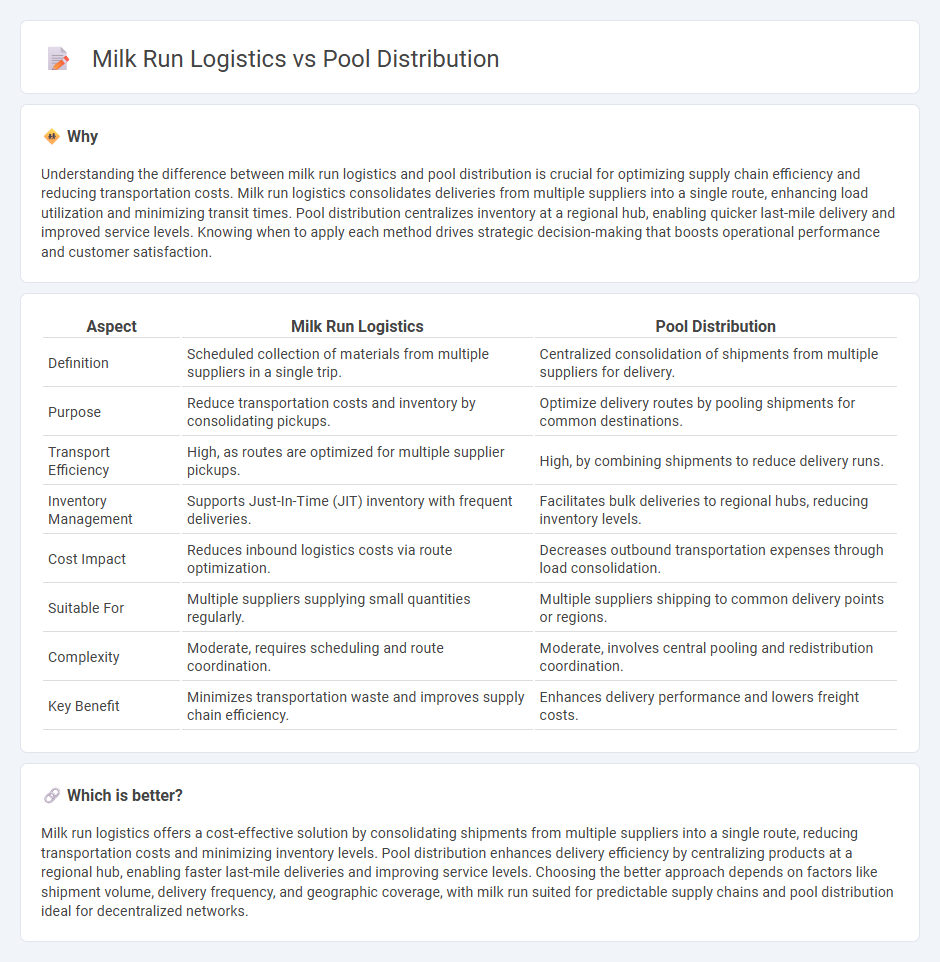
Milk run logistics optimizes transportation by consolidating multiple pickups and deliveries along a fixed route, reducing costs and improving efficiency. Pool distribution centralizes shipments from various suppliers into a single hub before delivering to customers, enhancing load utilization and minimizing transit times. Explore these methods to discover which strategy best suits your supply chain needs.
Why it is important
Understanding the difference between milk run logistics and pool distribution is crucial for optimizing supply chain efficiency and reducing transportation costs. Milk run logistics consolidates deliveries from multiple suppliers into a single route, enhancing load utilization and minimizing transit times. Pool distribution centralizes inventory at a regional hub, enabling quicker last-mile delivery and improved service levels. Knowing when to apply each method drives strategic decision-making that boosts operational performance and customer satisfaction.
Comparison Table
| Aspect | Milk Run Logistics | Pool Distribution |
|---|---|---|
| Definition | Scheduled collection of materials from multiple suppliers in a single trip. | Centralized consolidation of shipments from multiple suppliers for delivery. |
| Purpose | Reduce transportation costs and inventory by consolidating pickups. | Optimize delivery routes by pooling shipments for common destinations. |
| Transport Efficiency | High, as routes are optimized for multiple supplier pickups. | High, by combining shipments to reduce delivery runs. |
| Inventory Management | Supports Just-In-Time (JIT) inventory with frequent deliveries. | Facilitates bulk deliveries to regional hubs, reducing inventory levels. |
| Cost Impact | Reduces inbound logistics costs via route optimization. | Decreases outbound transportation expenses through load consolidation. |
| Suitable For | Multiple suppliers supplying small quantities regularly. | Multiple suppliers shipping to common delivery points or regions. |
| Complexity | Moderate, requires scheduling and route coordination. | Moderate, involves central pooling and redistribution coordination. |
| Key Benefit | Minimizes transportation waste and improves supply chain efficiency. | Enhances delivery performance and lowers freight costs. |
Which is better?
Milk run logistics offers a cost-effective solution by consolidating shipments from multiple suppliers into a single route, reducing transportation costs and minimizing inventory levels. Pool distribution enhances delivery efficiency by centralizing products at a regional hub, enabling faster last-mile deliveries and improving service levels. Choosing the better approach depends on factors like shipment volume, delivery frequency, and geographic coverage, with milk run suited for predictable supply chains and pool distribution ideal for decentralized networks.
Connection
Milk run logistics and pool distribution are connected through their shared focus on optimizing transportation efficiency and reducing costs in supply chains. Milk run logistics involves a single vehicle making multiple stops to collect or deliver goods, which complements pool distribution by consolidating shipments from various suppliers or destinations into a central hub for streamlined dispatch. This integration enhances route optimization, minimizes empty miles, and improves overall inventory management within logistics networks.
Key Terms
Consolidation
Pool distribution centralizes shipments from multiple suppliers to a single location, enabling efficient consolidation and reducing transportation costs by maximizing load capacity. Milk run logistics employs a continuous, scheduled route collecting smaller shipments from various points, enhancing delivery frequency and reducing inventory holding costs but often with less load optimization compared to pool distribution. Discover how these consolidation methods can optimize your supply chain efficiency and cost management.
Route Optimization
Pool Distribution consolidates shipments from multiple suppliers to a central hub, reducing transportation costs and improving load efficiency through optimized multimodal routes. Milk run logistics involves a single vehicle making multiple stops along a fixed route to collect or deliver smaller loads, minimizing empty miles and improving frequency. Explore in-depth comparisons to optimize your logistics strategy effectively.
Delivery Frequency
Pool distribution consolidates shipments from multiple suppliers to optimize delivery routes, reducing transportation costs and improving frequency by dispatching goods in bulk. Milk run logistics employs a fixed schedule to collect or deliver smaller quantities from multiple locations in a single trip, enhancing delivery frequency and minimizing inventory levels. Explore how delivery frequency impacts efficiency in both pool distribution and milk run logistics to optimize your supply chain.
Source and External Links
Pool Distribution - Pool distribution consolidates numerous orders for delivery within a specific geographic region, shipping them to a regional terminal where orders are staged for final local delivery, offering significant transportation cost savings especially for high volume shipments.
What is Pool Distribution? | Expak Logistics - Pool distribution involves consolidating multiple shipments at a regional terminal where they are sorted and reloaded onto smaller trucks for final delivery, reducing costs and improving shipment visibility for deliveries within a geographic region.
Pool Distribution Services in the Mid-Atlantic, Northeast & Southeast - Pool distribution services supply multiple locations from regional warehouses through a consolidated and technology-driven process that increases service levels while decreasing supply chain costs for retailers and distributors.
 dowidth.com
dowidth.com